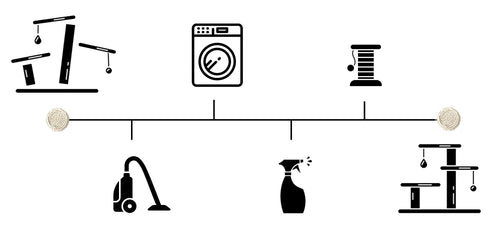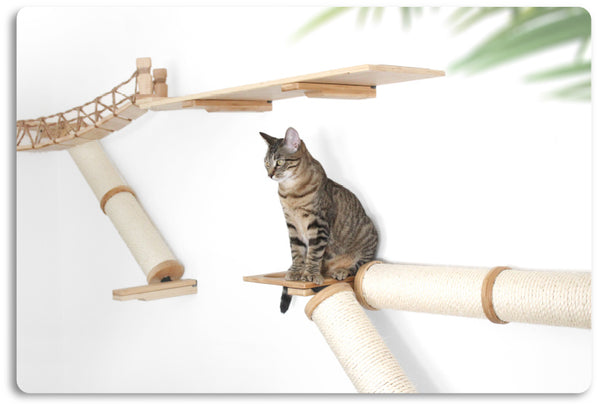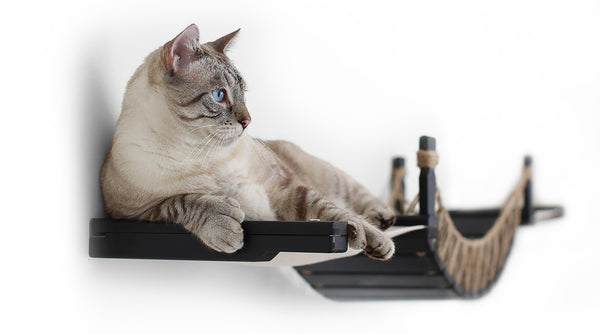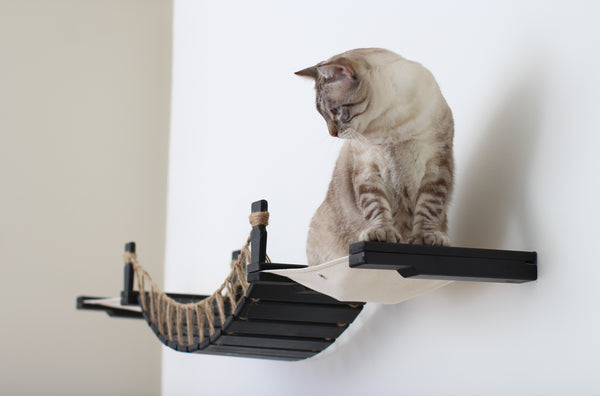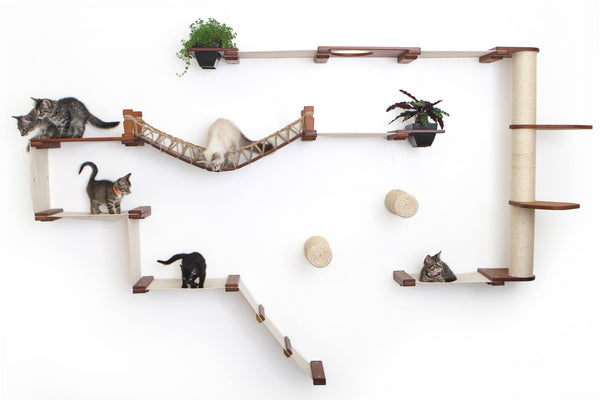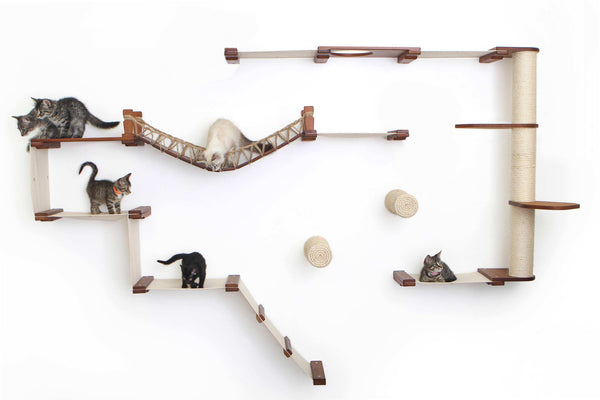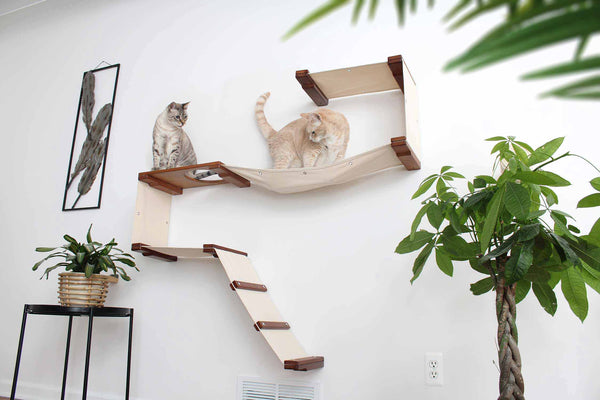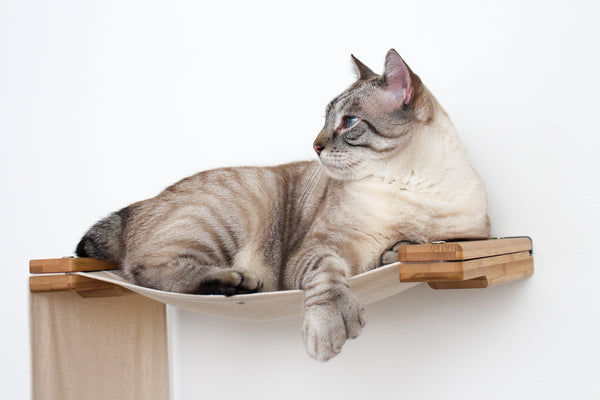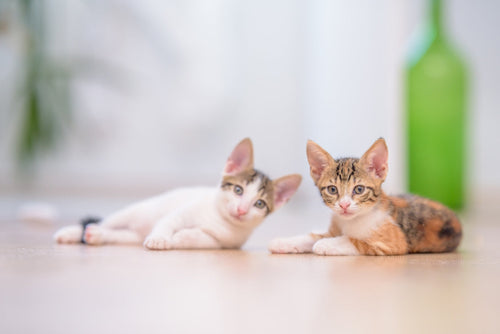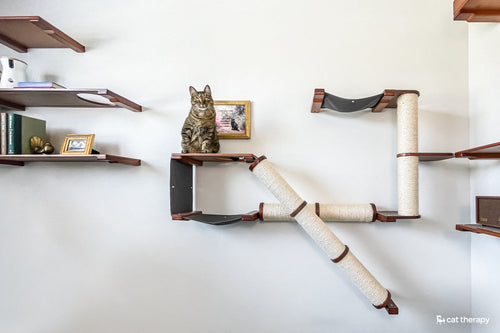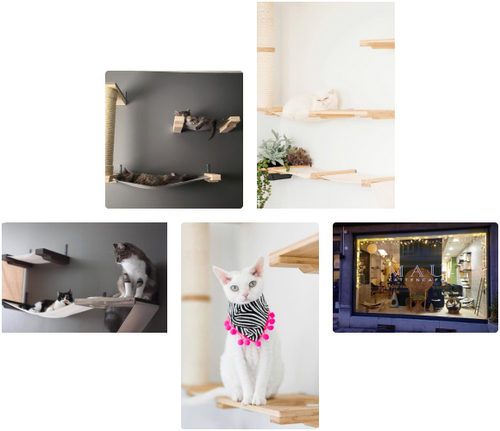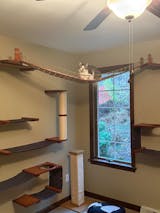Cat trees bring numerous benefits to your cat's life, but as you expand their environment with a new space to hang out, it's important to keep the cat tree clean. As cats play, lounge, and eat in their new habitat, the cat tree accumulates dirt, fur, food, and dust. Without regular cleaning, this provides an environment for bacteria to thrive. In this guide, we share simple steps you can take to create a healthier space for your cat while prolonging the life of your cat tree and keeping allergens out of the air in your home.
Content reviewed and approved by Dr. Erica Hawker
*Please note that we have included links to Amazon products, which are affiliate links. This means that we may receive a portion of the sale if one is made through the provided links. However, it's important to clarify that our choice of products is not influenced by the affiliate program. We have also included links to all products that were not available on Amazon and do not receive compensation for those links.
Why It’s Important to Clean Your Cat Tree
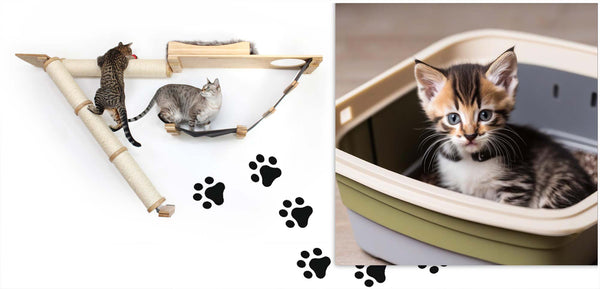
Even though cats have a well-earned reputation for being fastidious in their cleanliness, they can still spread germs - especially if they are fresh out of the litter box! Keeping their litter clean will help keep your house clean and your cat healthy. If your cat tree begins to smell like urine, please bring your cat to the vet! Elimination outside of the litter box could be a health issue. Just like a litter box, it's important to keep your cat tree clean for the health of everybody in your home.
Hygiene - Since most cats regularly shed their fur, it will inevitably accumulate in their favorite lounging areas. This build up can help trap dirt and debris.
Odor Control - Cleaning the surfaces your cat plays or lounges on will keep the furniture fresh and free of unwanted odors.
Reduce Allergens - Unfortunately, cat allergies are very common. Contributors to allergens in the air include proteins that are found in cat dander, saliva, and urine. Keeping up with a cleaning schedule will freshen up the air in your home.
Prevent Mold and Mildew - If a cat tree gets damp, mold and mildew can grow if left uncleaned. Proper weekly cleaning will help prevent the growth and spread of harmful pathogens.
How to Clean a Cat Tree - 6 Easy Steps

The following steps would be considered "how to deep clean a cat tree," which we suggest doing as needed. We also have recommendations for weekly and monthly cat tree cleaning.
1. Disassemble Cat Tree Parts
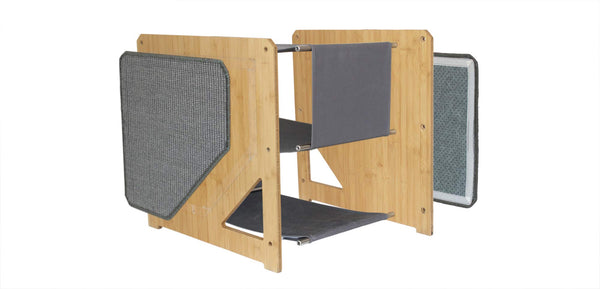
Cleaning a cat tree will be most thorough if you start by fully disassembling your tree. This will help separate the parts for different types of cleaning and also assist in removing dirt or grime hiding in the cracks.
Whether your cat tree is a tower on the ground or a wall-mounted version like our Modular Cat Trees, some level of disassembly can facilitate a more effective deep clean. For wall-mounted cat trees you can remove the plank tops but leave the fabric in place, unless you are removing fabric to run through the washing machine. We typically leave the Hammocks attached and wash them on the wall unless we're doing a very deep clean due to issues like ringworm or fleas.
2. Remove Cat Hair & Debris

Use a lint roller or cat brush to pick up excessive cat hair, then finish with a vacuum cleaner to suck up any remaining cat hair or debris. Do not skip these steps, even if you're planning to wash hammocks or plush beds in the washing machine. Cat hair will clump together when wet making it harder to remove.
~For those with cat allergies, weekly cat hair cleaning maintenance is recommended! I use a cat roller on the hammocks to keep them tidy and help prevent dander in the air.~
3. Wash Cat Tree Fabric

Evaluate the fabric pieces to see how dirty they are and determine if they are able to be machine-washed or wiped down with a towel lightly soaked with a pet-safe disinfectant. Although our cat trees are modular for easy washing, not all are. If you have a cat tree that doesn't allow you to detach the fabric, we suggest using the wiping method. ~ Be sure to test the cleaner in a small section, not easily visible to check for discoloration. ~
- Carpet - Since carpet can't be removed or go through the washing machine, use a pet-safe disinfectant to thoroughly soak the carpet and let it sit for 10 minutes. Scrub the surface thoroughly to remove dirt and grime trapped in the material. Be sure to soak up any excess fluid.
- Faux Fur/Plush Fur - Remove the cover from the foam padding if it has one. Hand washing will be the safest way to keep your plush from matting up. If you decide to use machine washing, place the fabric in a mesh bag and use a gentle, pet-safe detergent. Use cold water and a delicate cycle. Allow the fabric to air dry.
- Heavyweight Cotton Canvas Hammocks - Although our canvas is pre-washed to prevent shrinking, many are not. For best practice, we recommend hand washing canvas fabrics. If you decide to machine wash the Hammocks, be sure to wash them on a gentle cold cycle with a pet-safe detergent and stretch them back on the mounting planks to let them air dry.
Recommended pet-safe disinfectant solution:
- Seventh Generation All Purpose Cleaning (Spray)
- CleanSmart Daily Surface Cleaner (Spray)
- Seventh Generation Concentrated (Laundry Detergent)
4. Wipe Down Cat Tree Parts with Pet-Safe Disinfectant

Use a towel lightly soaked with pet-safe disinfectant, or gently spray the solution on any wooden parts or hammocks. Let the solution sit wet for the recommended time period and then wipe dry. There are many cleaning options out there, so be sure they are cat-safe. Avoid chemicals in disinfectants that can be harmful to cats. Here are some nice options:
- DIY Pet-Safe Disinfectant - Use equal parts of warm water and distilled white vinegar. Let sit wet 30 minutes.
- CleanSmart Daily Surface Cleaner - A top seller on Amazon, which kills germs and is safe to use around pets. The product says it's 100% chemical-free and doesn’t leave a residue, and to spray onto surfaces and allow it to air dry.
- REScue Spray - Keep out of reach from pets when wet, and wait 1 minute for the solution to sit prior to wiping clean.
- Tersano Pet-Safe Disinfectant - This is an expensive option, but was featured as one of Time Magazine’s best products of 2006. It works by electrically charging tap water to infuse it with ozone. This creates a strong pet-safe and chemical free disinfectant. They have a chart on their site with recommended periods of time to leave the solution prior to wiping clean.
- Steam Cleaning
5. Inspect & Rotate Cat Scratching Poles

Although Cat Scratching Poles are an item meant to be destroyed as cats scratch them, there are things you can do to prolong their life span. As you do a deeper clean once a month, we suggest having a look at where your cat is scratching these most. You can then rotate the poles or switch them out with another pole section that hasn’t been used as heavily.
6. Reassemble Cat Tree

After you have removed as much excess moisture as possible, the newly disinfected cat tree sections should be reconnected. Let any remaining damp fabric air dry.
When you re-attach the scratching poles to the cat tree, be sure to tighten them to the point that they are unable to rotate. If a cat jumps on a horizontal or angled pole while it’s loose, it can cause the pole to spin, which may result in them falling off. Such a startling experience may make them hesitant about using the poles in the future.
3 Tips for Cleaning Cat Trees & Cat Furniture
Tip #1 Avoid These Disinfectants
It’s always important to be cautious when using chemicals that can be harmful to pets. Although bleach is often mentioned when cleaning due to its effectiveness, your pet will need to be kept away while the chemical is being used. The following are some chemicals that are found in common household cleaners that can be harmful to your cats:
- Ammonia
- Bleach
- Isopropyl alcohol
- Formaldehyde (found in many household cleaners)
- Benzalkonium Chloride (found in Lysol wipes)
Tip #2 No Cat Hair in the Washing Machine!
Be sure to remove as much cat hair as you can prior to tossing it in the washing machine, or getting it wet. Not doing so can result in the hair clumping together, making it more difficult to remove.
Tip #3 Test Cleaning Solutions on Small Areas
Some chemicals may fade or alter the finish of your cat tree. It's always best to first test for discoloration in a small area prior to wiping down all of your cat tree parts.
Cleaning A Cat Tree FAQs

How often should I clean my cat tree?We typically suggest doing a light, weekly cleaning with a vacuum to pick up excess cat hair from the fabric material. You will also want to wipe down the solid pieces of the structure with a pet-safe dilution. This can all be done without taking any of the furniture apart. Every month we do a more thorough cleaning of the furniture, with a deep clean as needed. Depending on the type of cat tree you have, the fabric may either be wiped clean on the structure or removed for machine wash. Our furniture is made with cleaning in mind, with most of our Cat Trees using a heavyweight canvas that can be wiped down on the wall.
|
How to clean a cat tree from fleas?It’s a good idea to have your cats on flea prevention, even if they’re indoor cats. Be warned- getting rid of fleas is no easy task. It may take weeks before you are finally able to get your house back! Along with treating your house and pets for fleas, you will want to vacuum the cat tree on a daily basis. Make sure to empty the canister or bag outside to help prevent fleas from sneaking back in. If your cat tree is carpeted, steam cleaning the tower can be used as a flea treatment. Carpeting has many places to hide in the fibers, so exposing fleas to a high temperature may work better than using a spray. If you are able to remove the fabrics, washing the materials with hot, soapy water are effective at killing fleas. For more information on how to deal with a flea infestation, read this article. |
How to clean a cat tree for ringworm?Like fleas, ringworm can be very difficult to get rid of. If your cat tree is not easily laundered or disinfected, you may want to cut your losses and throw it out. It can be hard to get rid of something that gives your cat so much joy and comfort, so here are some cleaning tips you can use to try and salvage your cat condo. During the treatment duration, you may want to limit your cat’s access to the house. It will be much easier to repeatedly clean a smaller area, than your whole house! The first thing you will want to do is get rid of all the pet hair clinging to your tree. Use an electrostatic cloth on the non-porous surfaces to help trap spores and hair, then vacuum as much hair from the fabric surfaces as you can. Three is the lucky number here, so wash everything three times with a detergent. Remove excess water prior to disinfecting everything. Now, you will want to disinfect everything. During this stage, keep your pets away from the cat tree. Be sure to use a solution that can kill the ringworm spores. Some options are:
Remember to never mix disinfectants! Mixing chemicals can create toxic gasses. Please follow the safe handling instructions shown on the package. You will want to pick up excess hair daily, and disinfect twice a week until the ringworm is cured. For more information on how to get rid of ringworm in your home, take a look here. |
How to clean a carpeted cat tree?When cleaning a carpeted cat tree, start with a cat brush to get up the excess hair, then thoroughly vacuum any remaining hair and debris. Carpet traps in particles and grime at a higher rate compared to other fabrics like canvas, so you will want to invest more time in keeping the fibers free of dirt. Next, using a damp cloth, scrub the carpet with a pet-safe disinfectant. Use a dry towel to soak up the excess solution and let it air dry. |
When to replace a cat tree?A cat tree’s purpose is to bring enrichment to your cat’s life. If a cat tree is not doing that, or is becoming a health concern, it’s time to retire it. Look for the signs you should replace your cat tree.
|
How do you remove cat hair from a cat tree?Depending on the type of cat tree you have, we either suggest a pet hair roller or a cat brush and vacuum combo. We’ve had the best luck by using a pet hair roller weekly for Cat Hammock upkeep. If your cat tree has carpet, it’s best to start with a cat brush. After removing as much cat hair as possible, finish with a vacuum. Here are some best sellers from Amazon: |
How to clean a used cat tree?Since all cat trees are different and made from different materials, this is a difficult question to answer. We would advise against acquiring a used cat tree unless you know the medical history of the cats in the home it's coming from. Even with this information, you still run the risk of bringing undiagnosed parasites or contagions into your home if the previous owners are not yet aware of the outbreak. Because carpet can be especially difficult to clean, we would advise against bringing home a used cat tree made with that material unless you have a steam cleaner. If it’s one of our cat trees, we advise you to follow the 6 steps covered in deep cleaning a cat tree. As an extra precaution, you may want to consider replacing the more permeable sections such as the fabric and scratching poles. |
Cleaning your cat tree on a regular basis will keep it looking nice, help with unwanted odors, and make it a more pleasant space for your cat. Whenever you disassemble your cat furniture, keep an eye out for wear and tear. Scratching posts can be switched out or rotated to get the most life out of them. If you see loose or broken connections, try to find replacement parts to ensure the safety of your kitties. If replacements are not available, retire and replace your cat’s play structure!
Our Cat Trees are made to last a very long time. We still have first-generation cat condos, shelves, bridges, and hammock beds installed and used from when we first started building furniture in 2013. Fabric and Scratching Poles will need to be switched out eventually, but we’ve continually improved our design so the furniture is more modular, making switching parts out a snap.
References:
Consumer Product Information Database:
https://www.whatsinproducts.com/chemicals/view/1/2656/008001-54-5/Benzalkonium%20chloride
Shelter Medicine - School of Veterinary Medicine:
VetTechPrep:
https://blog.vettechprep.com/decontaminating-the-exam-room-and-home-when-a-pet-has-ringworm
VeterinaryPartner:
https://veterinarypartner.vin.com/default.aspx?pid=19239&catId=102903&id=7058488
Austin Pets Alive:
WebMD:
https://www.webmd.com/allergies/cat-allergies
https://www.webmd.com/pets/kill-fleas-at-home
CDC :
https://www.cdc.gov/fleas/getting_rid.html

